Study on Electromagnetic Focusing with Fully Phase-Adjustable High Transmittance Metasurface
Abstract
1. Introduction
2. Materials and Methods
3. Results
3.1. Design of Transmissive Metasurface Unit
3.2. Design and Simulation of Focusing Array
3.2.1. Analysis of Focusing
3.2.2. Analysis of Array Transmission Efficiency
3.3. Experiment and Analysis
4. Discussion
Author Contributions
Funding
Data Availability Statement
Conflicts of Interest
Abbreviations
| HFSS | High-Frequency Structure Simulator |
References
- Dai, J.Y.; Tang, W.; Chen, M.Z.; Chan, C.H.; Cheng, Q.; Jin, S.; Cui, T.J. Wireless communication based on information metasurfaces. IEEE Trans. Microw. Theory Tech. 2021, 69, 1493–1510. [Google Scholar] [CrossRef]
- Li, R.; Li, D.; Ma, J.; Feng, Z.; Zhang, L.; Tan, S.; Wei, E.I.; Chen, H.; Li, E.P. An electromagnetic information theory based model for efffcient characterization of MIMO systems in complex space. IEEE Trans. Antennas Propag. 2023, 71, 3497–3508. [Google Scholar] [CrossRef]
- Lin, M.; Yi, J.; Wang, J.; Zhu, L.; Jiang, Z.H.; Qi, P.; Chen, X. Single-layer re-organizable all-dielectric meta-lens platform for arbitrary transmissive phase manipulation at millimeterwave frequencies. IEEE Trans. Antennas Propag. 2022, 70, 2059–2069. [Google Scholar] [CrossRef]
- Shang, G.; Wang, Z.; Li, H.; Zhang, K.; Wu, Q.; Burokur, S.N.; Ding, X. Metasurface holography in the microwave regime. Photonics 2021, 8, 135. [Google Scholar] [CrossRef]
- Wu, Q.; Guan, X.; Zhang, R. Intelligent reffecting surface-aided wireless energy and information transmission: An overview. Proc. IEEE 2022, 110, 150–170. [Google Scholar] [CrossRef]
- Li, L.; Zhang, X.; Song, C.; Zhang, W.; Jia, T.; Huang, Y. Compact dual-band, wide-angle, polarization-angle-independent rectifying metasurface for ambient energy harvesting and wireless power transfer. IEEE Trans. Microw. Theory Tech. 2021, 69, 1518–1528. [Google Scholar] [CrossRef]
- Mukherjee, S.; Udpa, L.; Udpa, S.; Rothwell, E.J.; Deng, Y. A time reversal-based microwave imaging system for detection of breast tumors. IEEE Trans. Microw. Theory Tech. 2019, 67, 2062–2075. [Google Scholar] [CrossRef]
- Matsushima, K.; Noguchi, Y.; Yamada, T. Unidirectional invisibility in a PT-symmetric structure designed by topology optimization. Opt. Lett. 2022, 47, 3315–3318. [Google Scholar] [CrossRef]
- Wehner, R.S. Limitations of Focused Aperture Antennas; RAND Corporation: Santa Monica, CA, USA, 1949; pp. 608–610. [Google Scholar]
- Bickmore, R.W. Fraunhofer Pattern Measurement in the Fresnel Region. Can. J. Phys. 1957, 35, 1299–1308. [Google Scholar] [CrossRef]
- Sherman, J. Properties of focused apertures in the Fresnel region. IRE Trans. Antennas Propag. 1962, 10, 399–408. [Google Scholar] [CrossRef]
- Geyi, W. Enhancement of Backscattering by Electromagnetic Focusing. J. Univ. Electron. Sci. Technol. China 1996, 25, 177–184. [Google Scholar]
- Hu, J.; Yan, C.S.; Lin, Q.C. A new patch antenna with metamaterial cover. J. Zhejiang Univ. (Engl. Ed.) Ser. A Appl. Phys. Eng. 2006, 7, 6. [Google Scholar] [CrossRef]
- Lim, T.-H.; Kim, H.; Seo, C.; Choo, H. Design of Moiré-Inspired Metasurface Lens for Focusing Electromagnetic Power in Fresnel Near-Field Region. Energies 2022, 15, 3911. [Google Scholar] [CrossRef]
- Sun, Z.; Jiang, L.; Liu, R.; Du, M.; Cao, H. Electromagnetic focusing by zero orbital angular momentum system. Appl. Phys. Lett. 2021, 119, 181110. [Google Scholar] [CrossRef]
- Liu, Y.-Q.; Chen, W.; Du, X.; Shu, Y.; Wu, L.; Ren, Z.; Yin, H.; Sun, J.; Qi, K.; Che, Y.; et al. An ultra-thin high-efffciency plasmonic metalens with symmetric split ring transmitarray metasurfaces. Results Phys. 2023, 47, 106366. [Google Scholar] [CrossRef]
- Wu, S.; Zhang, Y.; Cui, X.; Zhang, J.; Xu, P. Electromagnetic near-field focusing based on metasurfaces. Opt. Commun. 2024, 553, 130125. [Google Scholar] [CrossRef]
- Wu, X.; Xue, H.; Zhao, S.; Han, J.; Chang, M.; Liu, H.; Li, L. Accurate and Efficient Method for Analyzing the Transfer Efficiency of Metasurface-Based Wireless Power Transfer System. IEEE Trans. Antennas Propag. 2023, 71, 783–795. [Google Scholar] [CrossRef]
- Song, C.M.; Trinh-Van, S.; Yi, S.H.; Bae, J.; Yang, Y.; Lee, K.Y.; Hwang, K.C. Analysis of Received Power in RF Wireless Power Transfer System With Array Antennas. IEEE Access 2021, 9, 76315–76324. [Google Scholar] [CrossRef]
- Yu, S.; Liu, H.; Li, L. Design of Near-Field Focused Metasurface for High-Efficient Wireless Power Transfer With Multifocus Characteristics. IEEE Trans. Ind. Electron. 2019, 66, 3993–4002. [Google Scholar] [CrossRef]
- Jiang, M.; Chen, Z.N.; Zhang, Y.; Hong, W.; Xuan, X. Metamaterialbased thin planar lens antenna for spatial beamforming and multibeam massive MIMO. IEEE Trans. Antennas Propag. 2017, 65, 464–4727. [Google Scholar] [CrossRef]
- Wu, R.Y.; Li, Y.B.; Wu, W.; Shi, C.B.; Cui, T.J. High-gain dual-band transmitarray. IEEE Trans. Antennas Propag. 2017, 65, 3481–3488. [Google Scholar] [CrossRef]
- Matos, S.A.; Lima, E.B.; Silva, J.S.; Costa, J.R.; Fernandes, C.A.; Fonseca, N.J.G.; Mosig, J.R. High gain dual-band beam-steering transmit array for Satcom terminals at Ka-band. IEEE Trans. Antennas Propag. 2017, 65, 3528–3539. [Google Scholar] [CrossRef]
- Abdelrahman, A.H.; Elsherbeni, A.Z.; Yang, F. High-Gain and Broadband Transmitarray Antenna Using Triple-Layer Spiral Dipole Elements. IEEE Antennas Wirel. Propag. Lett. 2014, 13, 1288–1291. [Google Scholar] [CrossRef]
- Li, L.; Zhang, P.; Cheng, F.; Chang, M.; Cui, T.J. An Optically Transparent Near-Field Focusing Metasurface. IEEE Trans. Microw. Theory Tech. 2021, 69, 2015–2027. [Google Scholar] [CrossRef]
- Li, H.; Wang, G.; Liang, J.; Gao, X.; Hou, H.; Jia, X. Single-Layer Focusing Gradient Metasurface for Ultrathin Planar Lens Antenna Application. IEEE Trans. Antennas Propag. 2017, 65, 1452–1457. [Google Scholar] [CrossRef]
- Lou, Q.; Chen, Z.N. Sidelobe Suppression of Metalens Antenna by Amplitude and Phase Controllable Metasurfaces. IEEE Trans. Antennas Propag. 2021, 69, 6977–6981. [Google Scholar] [CrossRef]
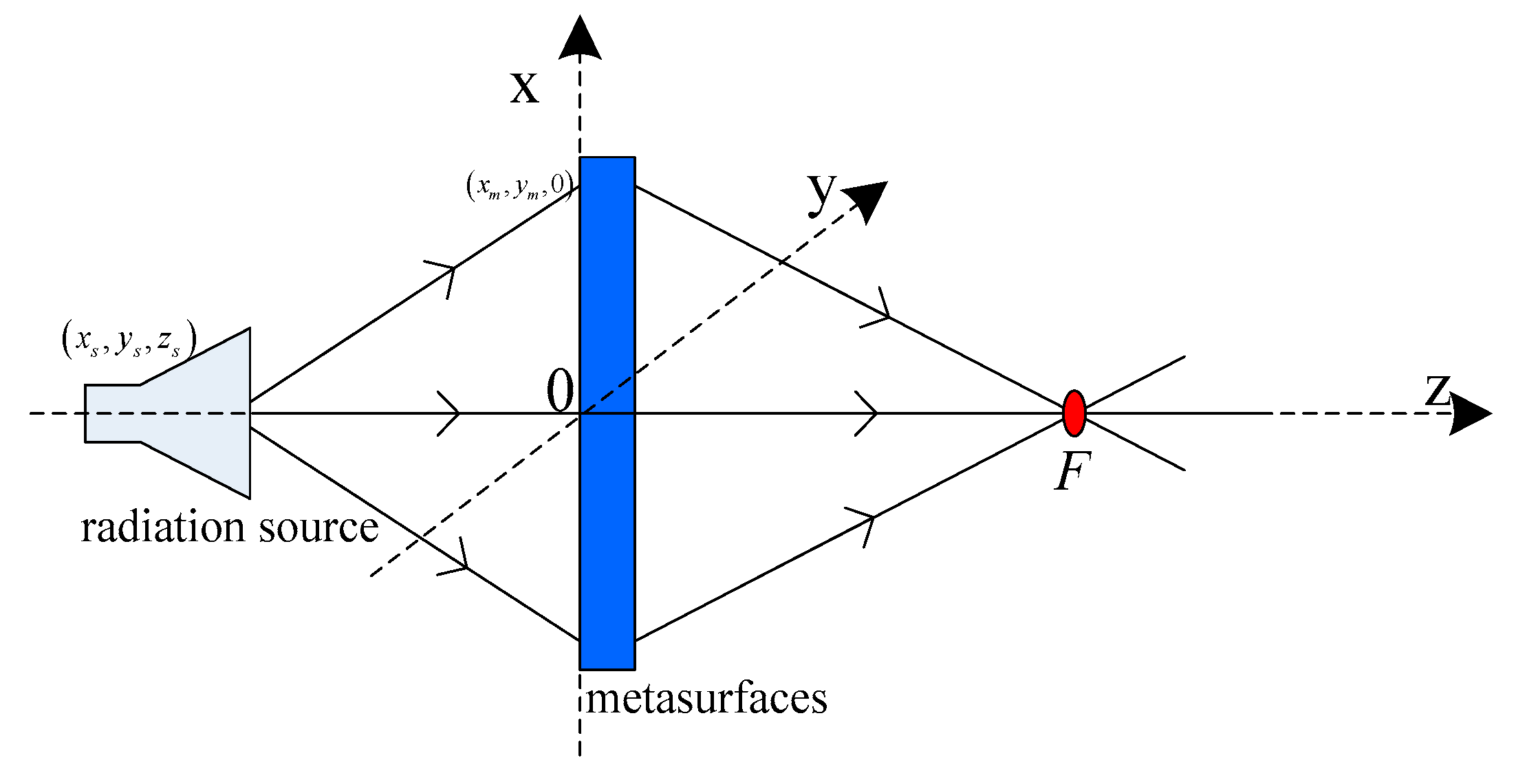

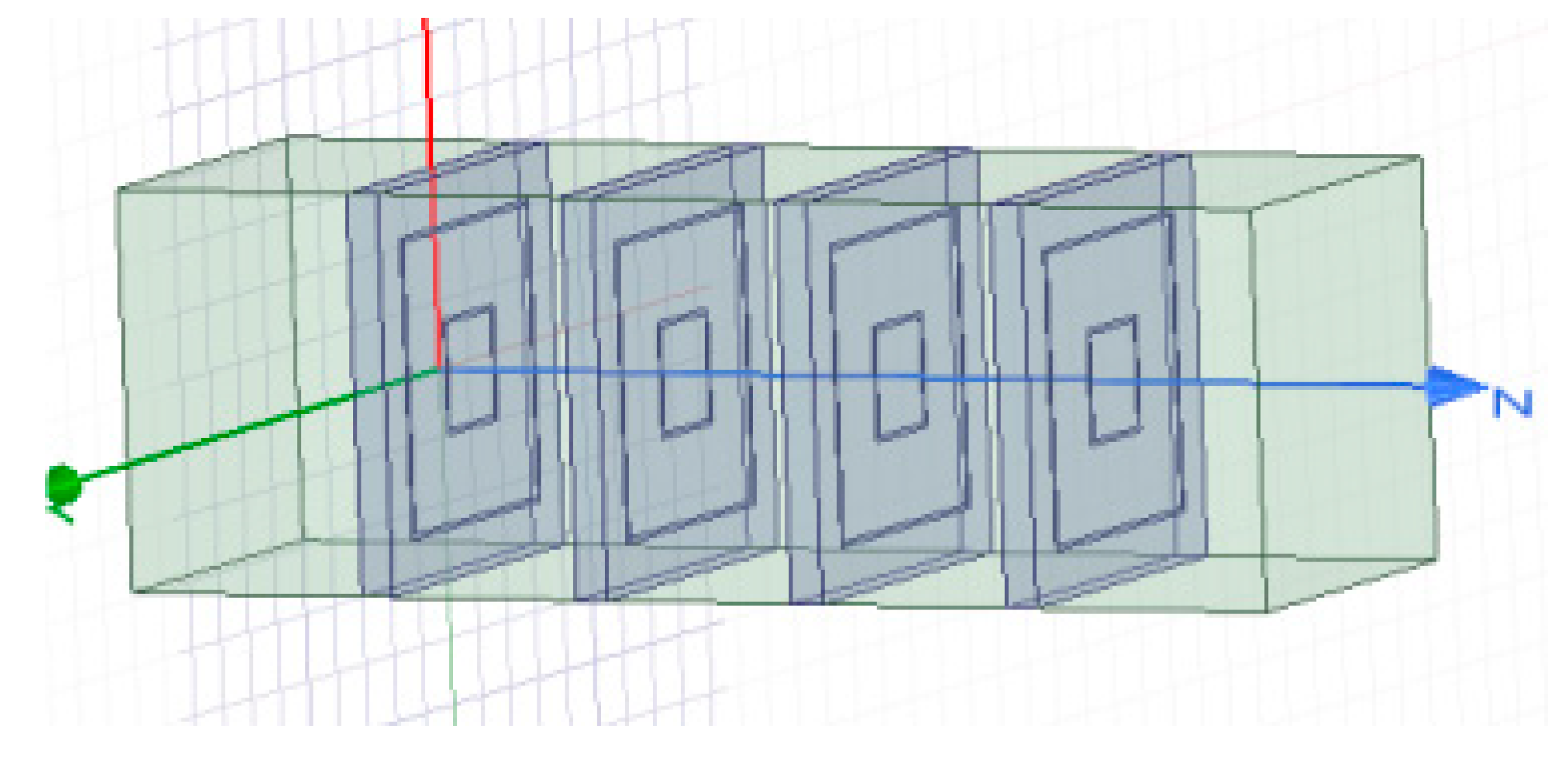




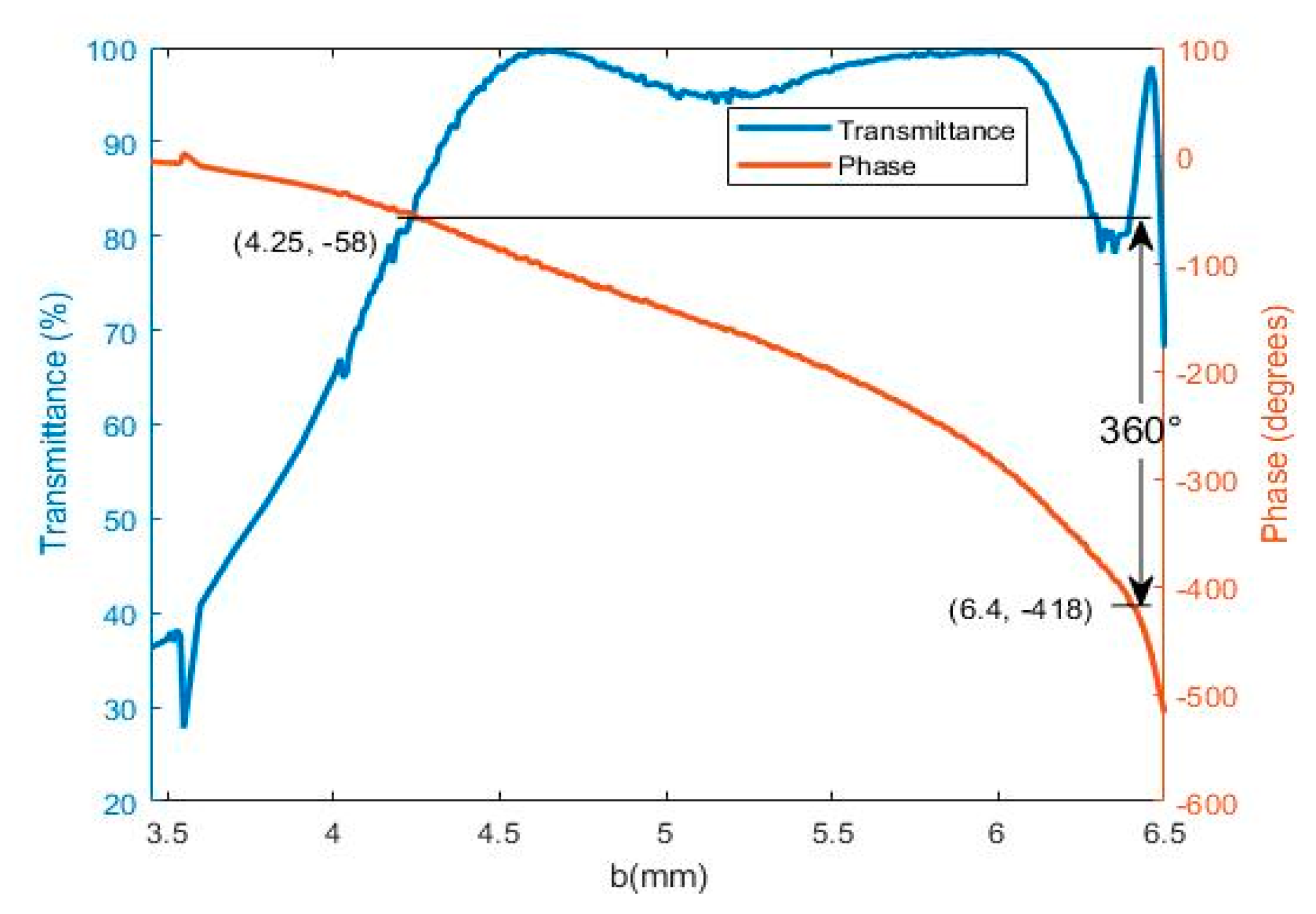

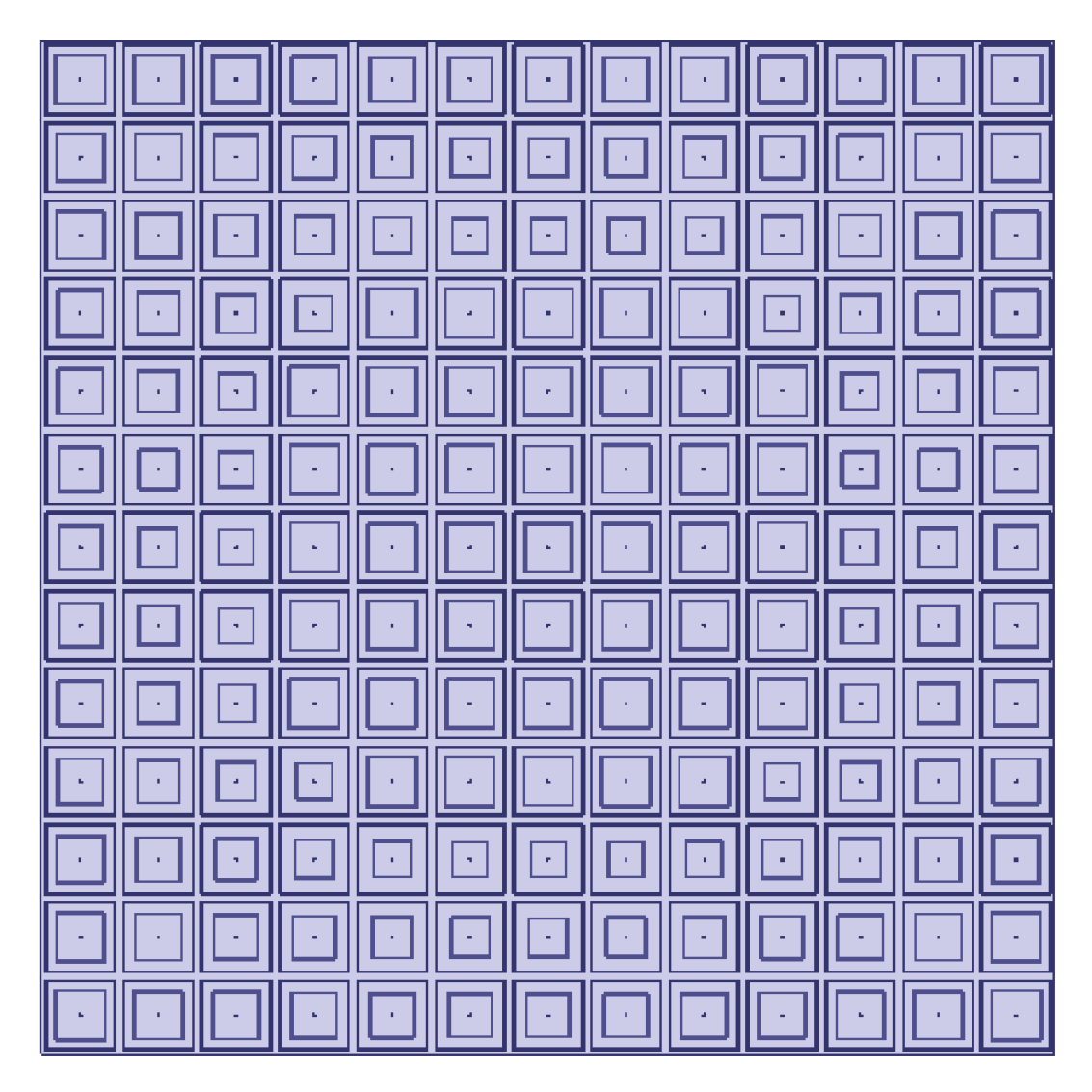
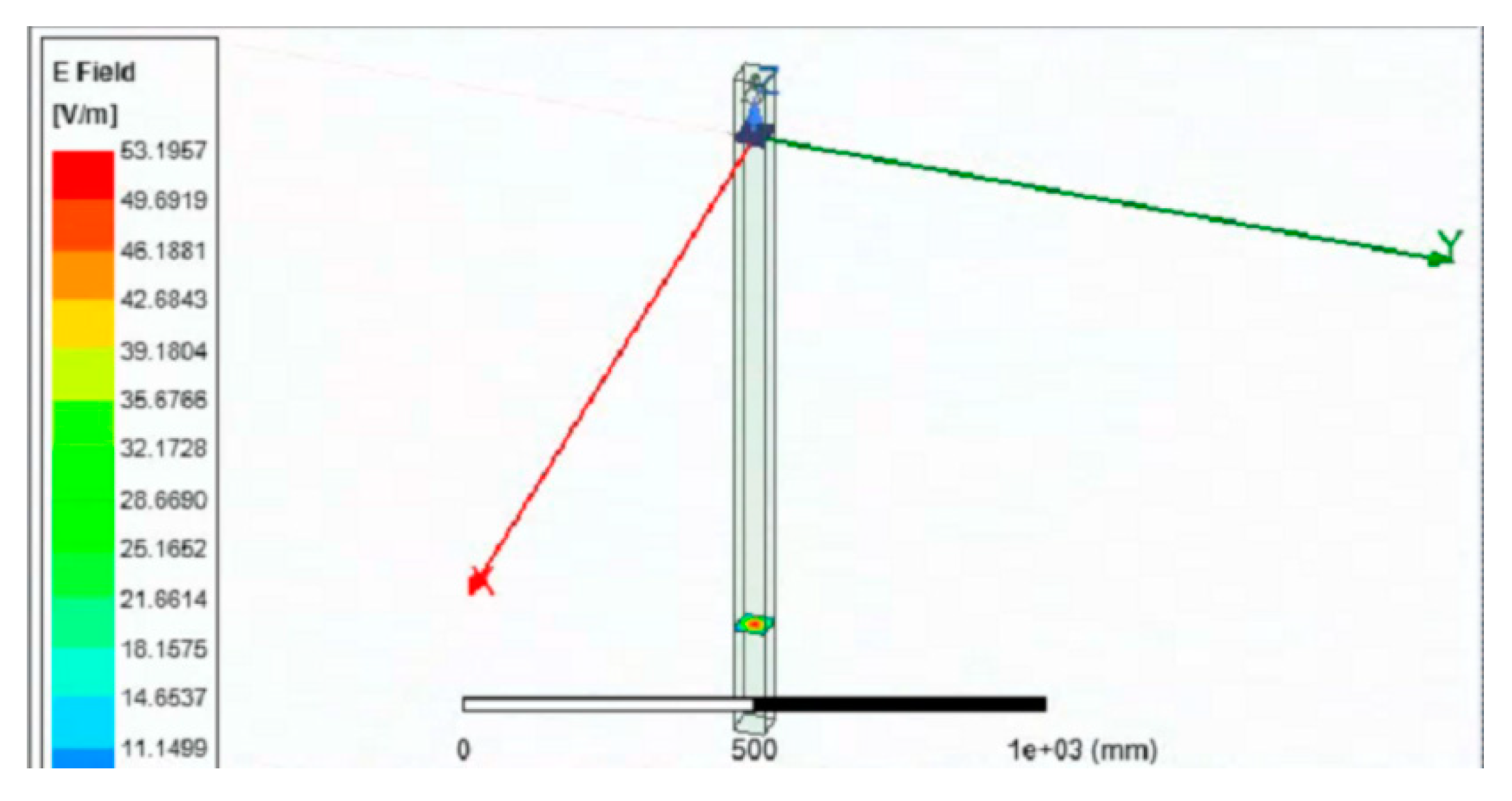


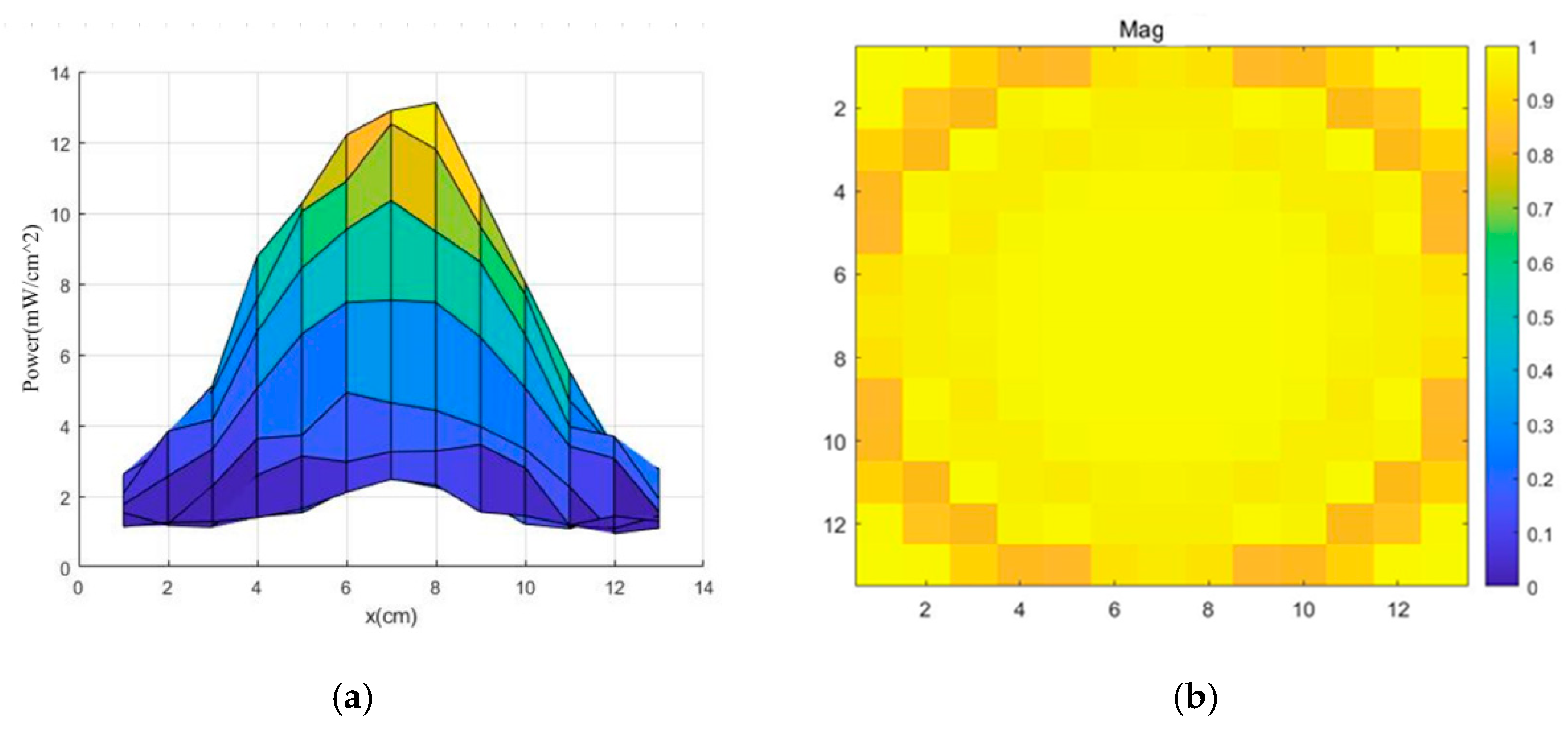
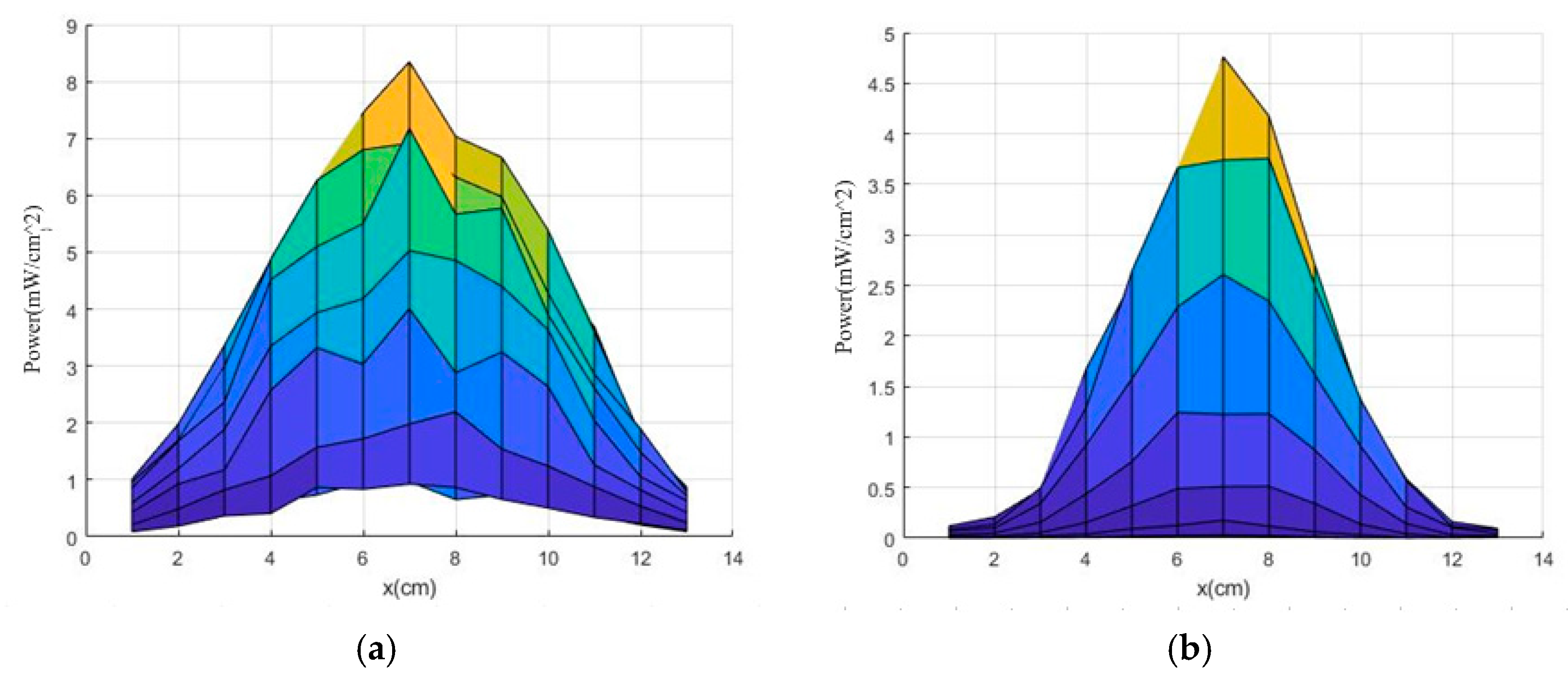

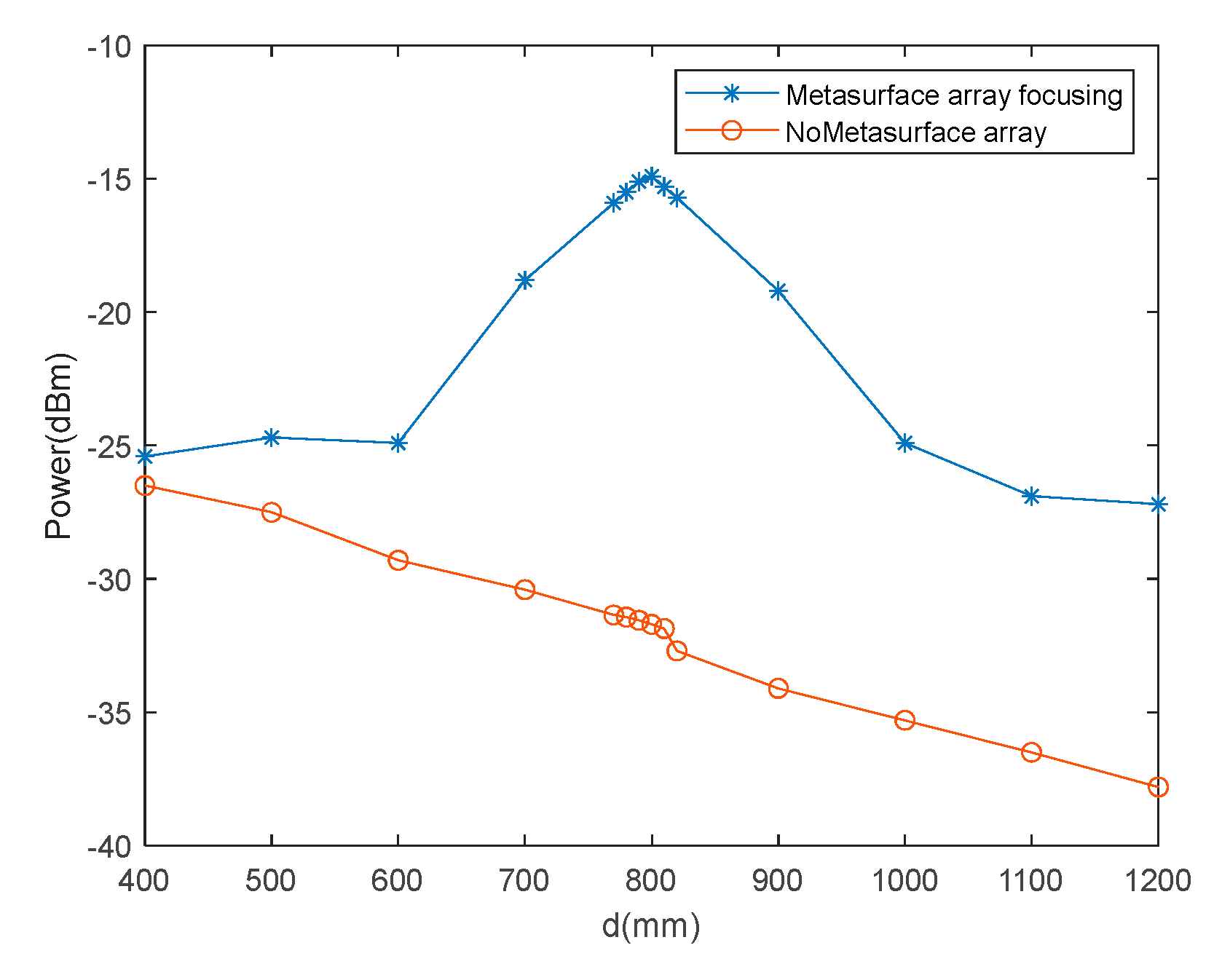
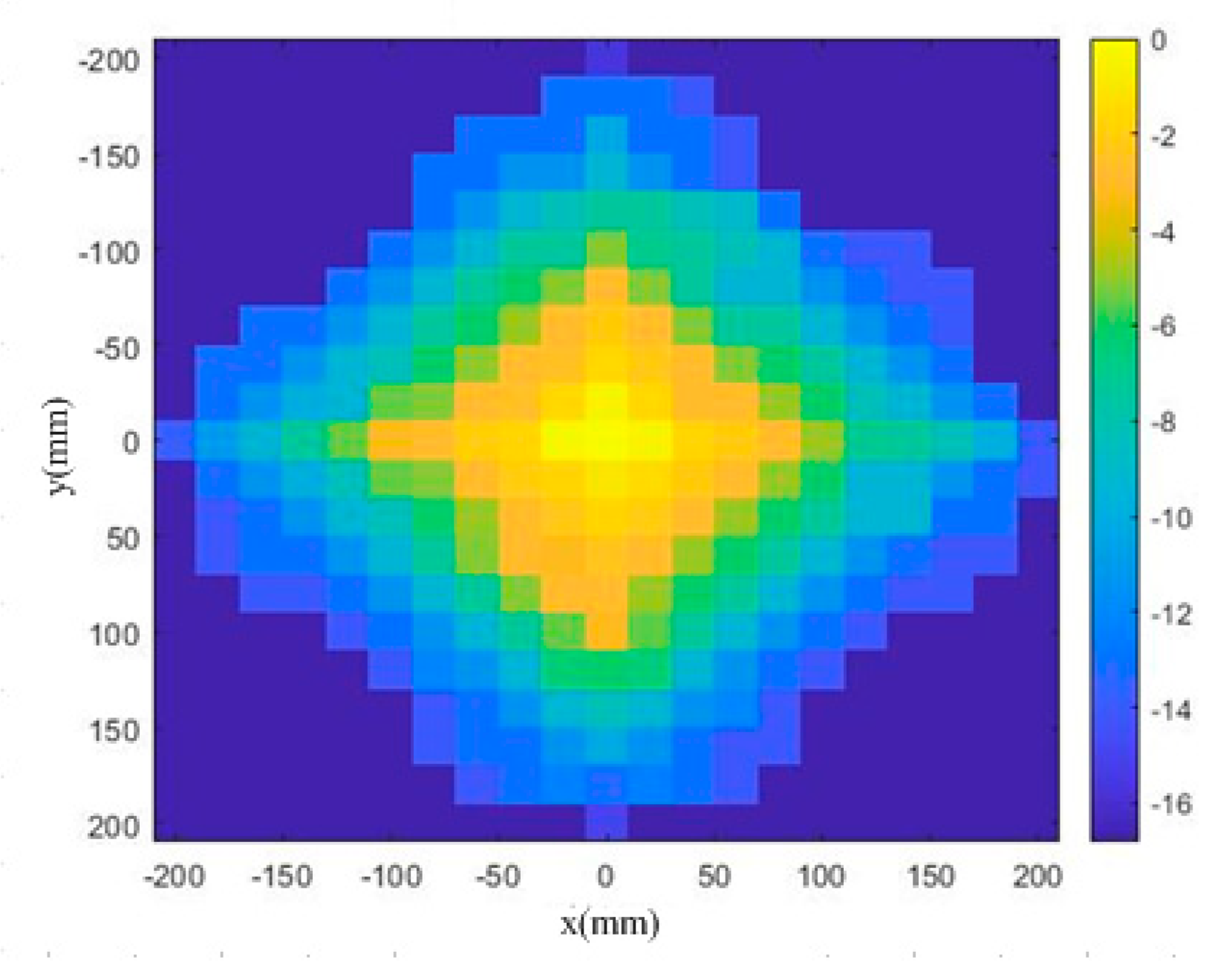
| Parameter | Description | Numerical Value |
|---|---|---|
| a | Length of upper metal ring | 9 mm |
| s | Width of upper metal ring | 0.15 mm |
| s1 | Length of lower metal ring | 0.15 mm |
| l | Interlayer gap width | 6 mm |
| h | Thickness of dielectric substrate | 0.4 mm |
| Rogers RT5880 | Dielectric substrate material | 2.2 |
| d | Unit side length | 10 mm |
| t | Copper layer thickness | 0.035 mm |
| b | Length of upper metal ring | 4.25–6.4 mm |
| Reference | Metasurface Structure | Attenuation (Transmittance) | Phase Shift |
|---|---|---|---|
| [27] | Square metal patches | −1 dB | 360° |
| [24] | Spiral-dipole shape | −4.2 dB | 270° |
| [25] | Cross-dipole structure | −2.5 dB | 350° |
| The work | Dual-sided metal ring structure | −0.9 dB (80%) | 360° |
| −308 | −239 | −180 | −132 | −97 | −75 | −67 | −75 | −97 | −132 | −180 | −239 | −308 |
| −239 | −166 | −104 | −53 | −15 | −351 | −343 | −351 | −15 | −53 | −104 | −166 | −239 |
| −180 | −104 | −37 | −343 | −303 | −277 | −269 | −277 | −303 | −343 | −37 | −104 | −180 |
| −132 | −53 | −343 | −286 | −243 | −216 | −207 | −216 | −243 | −286 | −343 | −53 | −132 |
| −97 | −15 | −303 | −243 | −198 | −170 | −160 | −170 | −198 | −243 | −303 | −15 | −97 |
| −75 | −351 | −277 | −216 | −170 | −141 | −131 | −141 | −170 | −216 | −277 | −351 | −75 |
| −67 | −343 | −269 | −207 | −160 | −131 | −121 | −131 | −160 | −207 | −269 | −343 | −67 |
| −75 | −351 | −277 | −216 | −170 | −141 | −131 | −141 | −170 | −216 | −277 | −351 | −75 |
| −97 | −15 | −303 | −243 | −198 | −170 | −160 | −170 | −198 | −243 | −303 | −15 | −97 |
| −132 | −53 | −343 | −286 | −243 | −216 | −207 | −216 | −243 | −286 | −343 | −53 | −132 |
| −180 | −104 | −37 | −343 | −303 | −277 | −269 | −277 | −303 | −343 | −37 | −104 | −180 |
| −239 | −166 | −104 | −53 | −15 | −351 | −343 | −351 | −15 | −53 | −104 | −166 | −239 |
| −308 | −239 | −180 | −132 | −97 | −75 | −67 | −75 | −97 | −132 | −180 | −239 | −308 |
| −64 | −54 | −46 | −40 | −36 | −33 | −32 | −33 | −36 | −40 | −46 | −54 | −64 |
| −54 | −45 | −37 | −30 | −26 | −23 | −23 | −23 | −26 | −30 | −37 | −45 | −54 |
| −46 | −37 | −29 | −23 | −18 | −15 | −15 | −15 | −18 | −23 | −29 | −37 | −46 |
| −40 | −30 | −23 | −16 | −12 | −9 | −9 | −9 | −12 | −16 | −23 | −30 | −40 |
| −36 | −26 | −18 | −12 | −9 | −5 | −5 | −5 | −9 | −12 | −18 | −26 | −36 |
| −33 | −23 | −15 | −9 | −5 | 0 | 0 | 0 | −5 | −9 | −15 | −23 | −33 |
| −32 | −23 | −15 | −9 | −5 | 0 | 0 | 0 | −5 | −9 | −15 | −23 | −32 |
| −33 | −23 | −15 | −9 | −5 | 0 | 0 | 0 | −5 | −9 | −15 | −23 | −33 |
| −36 | −26 | −18 | −12 | −9 | −5 | −5 | −5 | −9 | −12 | −18 | −26 | −36 |
| −40 | −30 | −23 | −16 | −12 | −9 | −9 | −9 | −12 | −16 | −23 | −30 | −40 |
| −46 | −37 | −29 | −23 | −18 | −15 | −15 | −15 | −18 | −23 | −29 | −37 | −46 |
| −54 | −45 | −37 | −30 | −26 | −23 | −23 | −23 | −26 | −30 | −37 | −45 | −54 |
| −64 | −54 | −46 | −40 | −36 | −33 | −32 | −33 | −36 | −40 | −46 | −54 | −64 |
| −12 | −293 | −226 | −172 | −133 | −108 | −99 | −108 | −133 | −172 | −226 | −293 | −12 |
| −293 | −211 | −141 | −83 | −41 | −14 | −6 | −14 | −41 | −83 | −141 | −211 | −293 |
| −226 | −141 | −66 | −6 | −321 | −292 | −284 | −292 | −321 | −6 | −66 | −141 | −226 |
| −172 | −83 | −6 | −302 | −255 | −225 | −215 | −225 | −255 | −302 | −6 | −83 | −172 |
| −133 | −41 | −321 | −255 | −206 | −175 | −164 | −175 | −206 | −255 | −321 | −41 | −133 |
| −108 | −14 | −292 | −225 | −175 | −143 | −132 | −143 | −175 | −225 | −292 | −14 | −108 |
| −99 | −6 | −284 | −215 | −164 | −132 | −121 | −132 | −164 | −215 | −284 | −6 | −99 |
| −108 | −14 | −292 | −225 | −175 | −143 | −132 | −143 | −175 | −225 | −292 | −14 | −108 |
| −133 | −41 | −321 | −255 | −206 | −175 | −164 | −175 | −206 | −255 | −321 | −41 | −133 |
| −172 | −83 | −6 | −302 | −255 | −225 | −215 | −225 | −255 | −302 | −6 | −83 | −172 |
| −226 | −141 | −66 | −6 | −321 | −292 | −284 | −292 | −321 | −6 | −66 | −141 | −226 |
| −293 | −211 | −141 | −83 | −41 | −14 | −6 | −14 | −41 | −83 | −141 | −211 | −293 |
| −12 | −293 | −226 | −172 | −133 | −108 | −99 | −108 | −133 | −172 | −226 | −293 | −12 |
Disclaimer/Publisher’s Note: The statements, opinions and data contained in all publications are solely those of the individual author(s) and contributor(s) and not of MDPI and/or the editor(s). MDPI and/or the editor(s) disclaim responsibility for any injury to people or property resulting from any ideas, methods, instructions or products referred to in the content. |
© 2025 by the authors. Licensee MDPI, Basel, Switzerland. This article is an open access article distributed under the terms and conditions of the Creative Commons Attribution (CC BY) license (https://creativecommons.org/licenses/by/4.0/).
Share and Cite
Zhu, Z.; Zhou, X. Study on Electromagnetic Focusing with Fully Phase-Adjustable High Transmittance Metasurface. Electronics 2025, 14, 669. https://doi.org/10.3390/electronics14040669
Zhu Z, Zhou X. Study on Electromagnetic Focusing with Fully Phase-Adjustable High Transmittance Metasurface. Electronics. 2025; 14(4):669. https://doi.org/10.3390/electronics14040669
Chicago/Turabian StyleZhu, Zhaoxuan, and Xin Zhou. 2025. "Study on Electromagnetic Focusing with Fully Phase-Adjustable High Transmittance Metasurface" Electronics 14, no. 4: 669. https://doi.org/10.3390/electronics14040669
APA StyleZhu, Z., & Zhou, X. (2025). Study on Electromagnetic Focusing with Fully Phase-Adjustable High Transmittance Metasurface. Electronics, 14(4), 669. https://doi.org/10.3390/electronics14040669





